What Size Mountain Bike Do I Need?
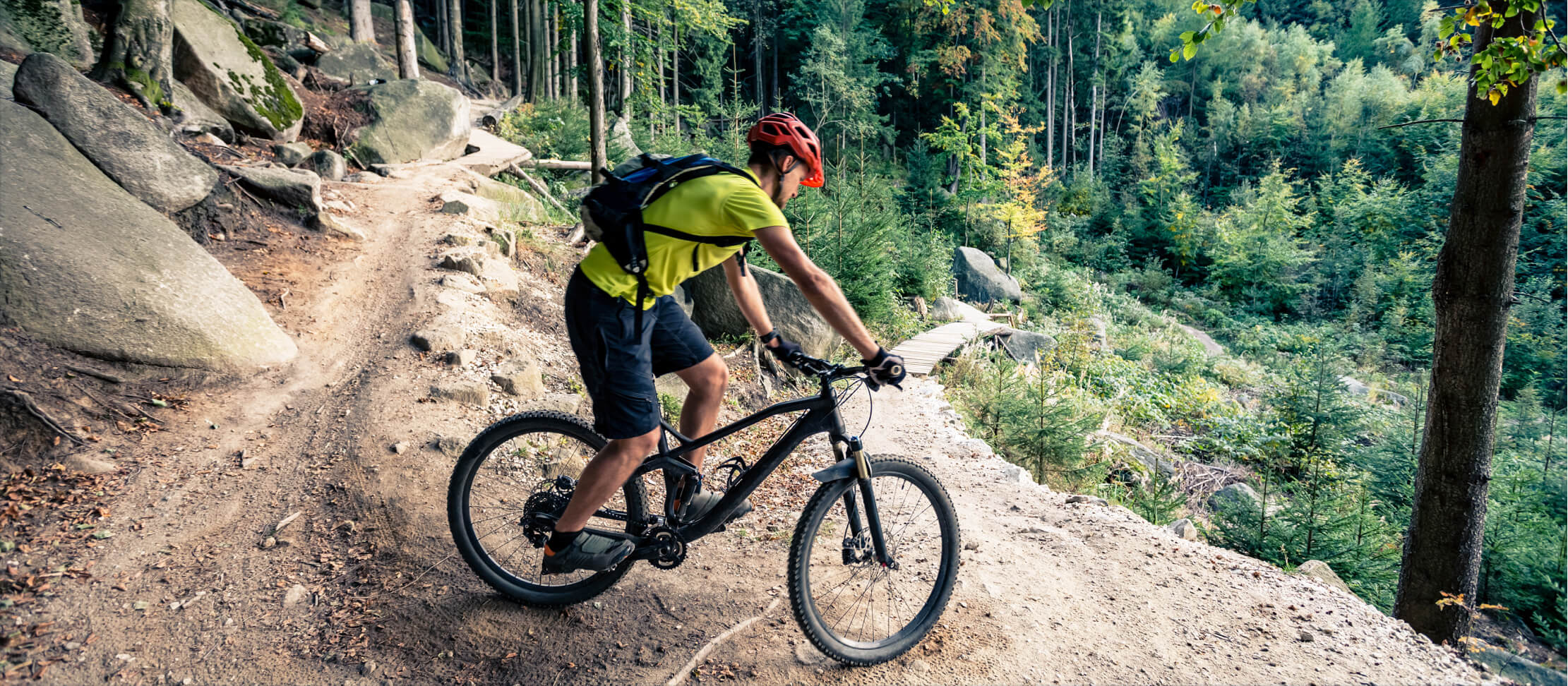
Ready to hear the exhilarating crunch of off-road trail rocks, brush, or gravel under your tires? You’ll have to pedal your way to the best-kept sights on a properly fitting mountain bike.
In our complete guide, we'll walk you through the ins and outs of finding the perfect size mountain bike. From understanding the impact of your riding style and torso length on the fit to exploring key considerations, we've got you covered!
Key Takeaways
- Discover what size mountain bike you need with our mountain bike size charts for both men and women.
- Learn how mountain bikes are sized and why you’ll need to make adjustments to the bike for a perfect fit.
- Find out if you need to size up or down if you’re in-between sizes and how your torso and leg length and flexibility will impact your bike size.
- Learn how to choose a mountain bike + the perfect fit with our expert guidance on effective standover height, wheel size, and much more.
What Size Mountain Bike Do I Need?
Shopping for a mountain bike and don’t know where to start? Knowing your height is essential when determining the proper mountain bike size for you.
Mountain Bike Size Chart
Locate your height on our unisex/men’s mountain bike size chart below. This will give you a great starting point whether you’re shopping online or in person.
| Rider Height (in) | Rider Height (cm) | Frame Size | Frame Size (in) | Frame Size (cm) |
| 4'10" - 5'2" | 148 - 158 | XS | 13" - 14" | 33-37 |
| 5'2" - 5'6" | 158 - 168 | S | 15" - 16" | 38-42 |
| 5'6" - 5' 10" | 168 - 178 | M | 17" - 18" | 43-47 |
| 5'10" - 6'1" | 178 - 185 | L | 19" - 20" | 48-52 |
| 6'1" - 6'4" | 185 - 193 | XL | 21" - 22" | 53-57 |
| 6'4" - 6'6" | 193 - 198 | XXL | 23" - 24" | 58-61 |
Women’s Mountain Bike Size Chart
Women’s mountain bikes typically feature smaller frames and narrower handlebars tailored to fit the needs of shorter riders. Use our mountain bike size chart for women below. But don’t forget to check the manufacturer’s sizing specifications for more clarity.
| Rider Height (in) | Rider Height (cm) | Frame Size | Frame Size (in) | Frame Size (cm) |
| 4'10" - 5'2" | 148 - 158 | XS | 13" - 14" | 33-37 |
| 5'2" - 5'6" | 158 - 168 | S | 15" - 16" | 38-42 |
| 5'6" - 5' 10" | 168 - 178 | M | 17" - 18" | 43-47 |
| 5'10" - 6'1" | 178 - 185 | L | 19" - 20" | 48-52 |
How Are Mountain Bikes Sized?
When it comes to mountain bikes, most manufacturers offer frame sizes categorized as small, medium, and large. These sizes can be adjusted further by modifying the seat height or angle to ensure a better fit. You’ll find they also come in various shapes.
You can test-ride different sizes in-store. That way you can personally experience any variations and determine the most suitable option for your needs with confidence.
Expert Tip:
Each brand typically has its own sizing charts that you should consult before making a purchase.
What if I’m In-Between Mountain Bike Sizes?
If you find yourself in-between sizes, opting for the smaller size is generally recommended.
- If You Have a Longer Torso: If you have a longer torso and prefer a neutral riding position, sizing up might be a better choice. This will give you more room for your arms and legs.
- If You Aren’t Flexible: If you have limited flexibility, a smaller bike can provide better maneuverability. You’ll feel closer to the ground and won’t feel as stretched when riding.
- If You Are Flexible: If you have more flexibility and desire a more aggressive riding position, using a longer bike can be suitable.
- If You Aren’t Flexible But Have a Shorter Torso: If you have limited flexibility, longer legs, a shorter torso, and prefer a more upright riding position, sizing down can offer a more comfortable experience.
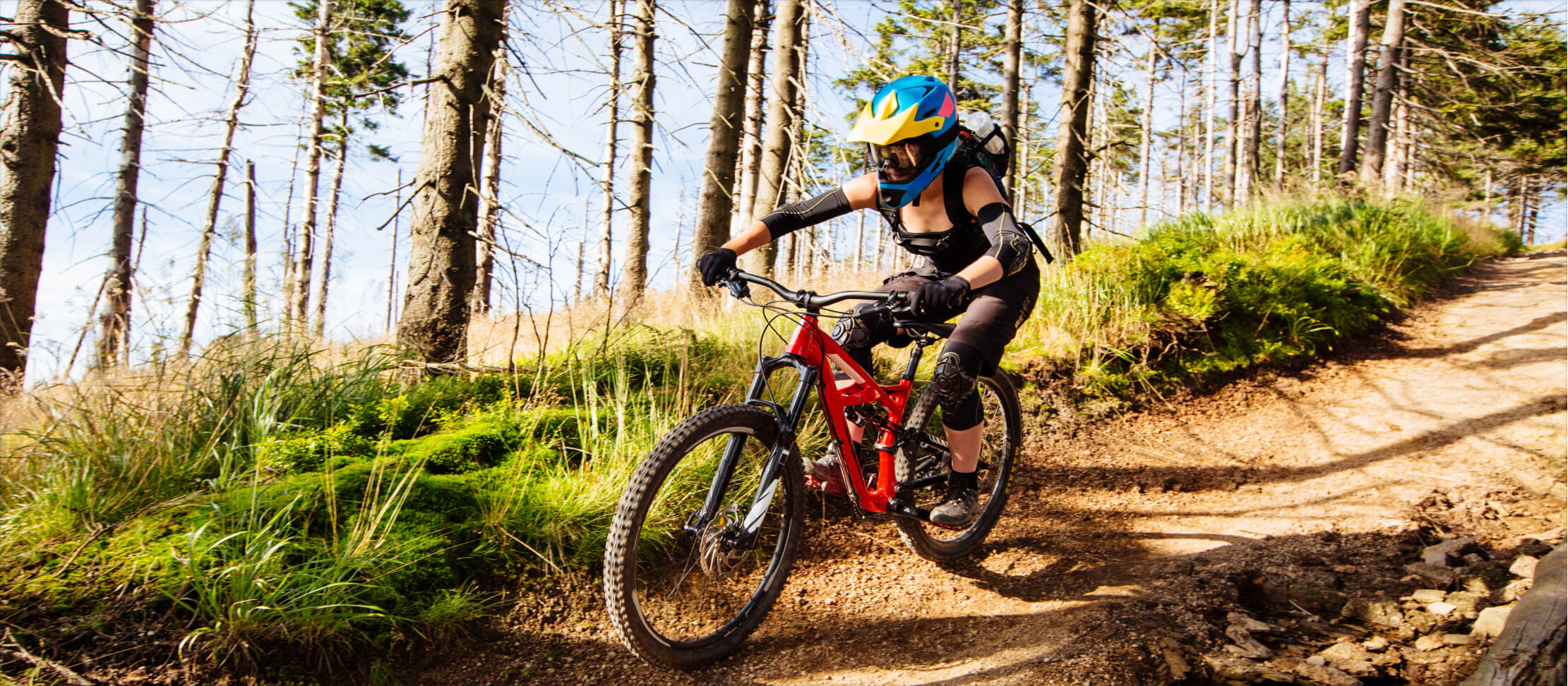
How to Choose a Mountain Bike + the Perfect Fit
Understanding the geometry of a mountain bike and the various measurements can provide valuable insights to help you find the perfect fit for your riding style and body proportions. Explore these factors so you can make the best call when shopping for a mountain bike.
- Reach: Reach refers to the horizontal distance from the bottom bracket center to the top of the head tube — not to the handlebars.
- Effective Top Tube: Measure the effective top tube to establish a bike's horizontal length, a critical factor in determining your riding position.
- Standover Height: The standover height (or the space between you and the bike when standing) should be comfortable enough to allow for easy maneuvering.
- Seat Height: Correctly adjusting the mountain bike seat height allows for optimal pedaling efficiency and reduces the risk of knee injuries.
- Wheel Size (27.5 vs. 29): 27.5" wheels are agile for tight trails, while 29" wheels roll over obstacles better and maintain speed.
- Head Tube Angle: A steeper angle improves climbing efficiency, while a slacker angle enhances downhill stability.
- Chainstay Length: Shorter chainstays provide agile handling, whereas longer ones contribute to a bike's stability at speed.
- Bottom Bracket Height: A lower bracket increases stability, but higher positioning prevents pedal strikes on uneven terrain.
- Wheelbase: Longer wheelbases offer stability at high speeds. Shorter wheelbases allow for more maneuverability.
Mountain Bike Reach
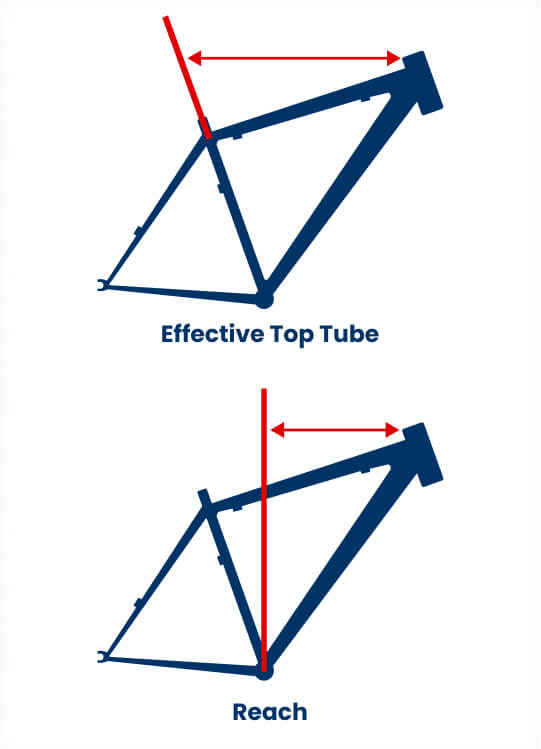
Reach helps to determine the overall feel of a mountain bike. This measurement represents the horizontal distance from the center of the bottom bracket to the center of the head tube.
- It influences your experience when standing up on the pedals to navigate a steep incline.
- Reach tends to vary significantly when transitioning between different sizes, having a more noticeable impact compared to the stack measurement.
- Reach can affect comfort, stability, and control when mountain biking.
Mountain Bike Effective Top Tube
The effective top tube measurement of a mountain bike refers to the horizontal distance between the center of the head tube and the center of the seat post.
- This measurement helps determine the amount of space available to you when you're seated in the saddle.
- A longer effective top tube provides a roomier, more stretched-out riding position. This can be advantageous for riders seeking a more aerodynamic and aggressive stance.
- A shorter effective top tube offers a more compact and upright position. This provides enhanced maneuverability and control — especially in technical terrains.
Mountain Bike Standover Height

The standover height refers to the measurement from the ground to the top tube of the bike when you're standing in front of the seat.
- You should have roughly 2-5 inches of standover height — depending on your riding style and preferences. Riders who perform advanced maneuvers (like jumps) may want greater clearance.
- To find your perfect standover height, measure your inseam with shoes on and compare it to the brand's specified standover height.
- Mountain bikes naturally have low standover heights. Relying solely on this method may not always be accurate.
Mountain Bike Seat Height
Your seat height on a mountain bike should accommodate comfort and performance. To get the perfect seat height, follow our recommendations:
- Position yourself on the bike so your heel barely touches the pedal when your leg is fully extended and your knee is straight.
- Pay attention to your hips while pedaling. There shouldn't be excessive rocking back and forth. If you experience this, the saddle may be too high. Consider lowering it slightly.
Expert Tip:
On steep descents, choose to lower the saddle. This adjustment enhances control and allows for better weight distribution. It also lowers your center of gravity. Both improve your overall stability and maneuverability on challenging terrains.
Mountain Bike Wheel Size: 27.5 vs. 29
Mountain bike wheel sizes play a significant role in the overall performance and characteristics of the bike. The 26-inch wheel size is standard; however, 27.5 inches and 29 inches are both gaining popularity.
| 27.5 vs. 29 Mountain Bike Wheel Size | |||||
|---|---|---|---|---|---|
| Wheel Size | Best Suited For | Strengths | Weaknesses | ||
| 27.5 in. | Beginners |
|
|
||
| 29 in. | Those who like a stable and planted feel |
|
|
||
Mountain Bike Head Tube Angle
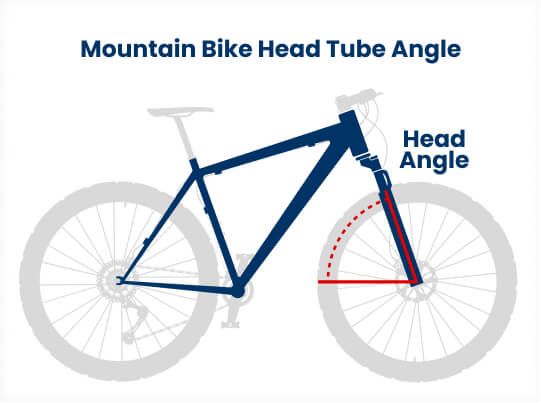
The head tube angle refers to the angle between the front fork of the bike and the ground. Most mountain bikes have a head tube angle ranging from 66-68 degrees. Evaluate the head tube angle based on your riding preferences and the type of terrain you'll be tackling.
- A slack head tube angle (e.g. 66 degrees) offers increased stability when riding at higher speeds or navigating downhill sections. It also helps to maintain a planted feel on trails.
- Steeper head tube angles (e.g. 68 degrees) are best when climbing uphill. They shift more weight onto the front tire — preventing the risk of flipping backward and providing better traction and control on steep ascents.
Mountain Bike Chainstay Length
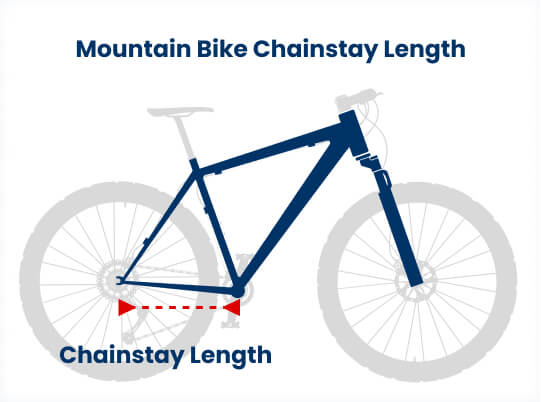
The chainstay length of a mountain bike refers to the distance between the center of the bottom bracket and the center of the rear axle. The choice between shorter and longer chainstays ultimately comes down to personal preference and riding style:
- Shorter chainstays bring the rider's rear wheel closer to them, making it easier to perform wheelies and other tricks that require rear-wheel control.
- Longer chainstays provide more stability, especially when navigating challenging terrain or riding at higher speeds.
Expert Tip:
Riders who prioritize agility and playful maneuvering may prefer shorter chainstays, while those seeking enhanced stability and confidence might opt for longer chainstays.
Mountain Bike Bottom Bracket Height
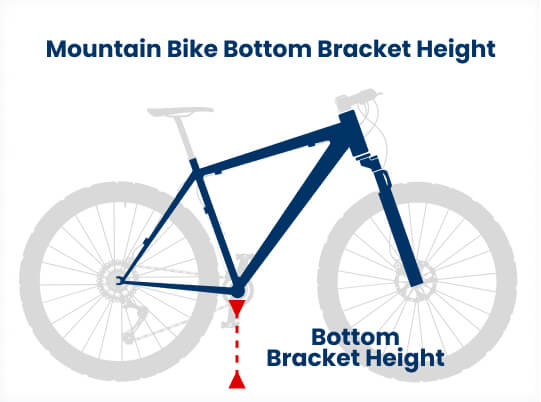
The bottom bracket height of a mountain bike is determined by the distance from the ground to the center of the bottom cranks. Riders should consider the specific terrain they'll be riding on and their skill level to determine the ideal bottom bracket height for their mountain bike.
- A lower bottom bracket height means that your center of mass is closer to the ground, resulting in improved stability, especially when taking corners at high speeds.
- The lower center of gravity allows for better control and maneuverability through tight turns and technical sections. However, being closer to the ground can also increase the chances of kicking up rocks, branches, and other trail obstacles.
Mountain Bike Wheelbase
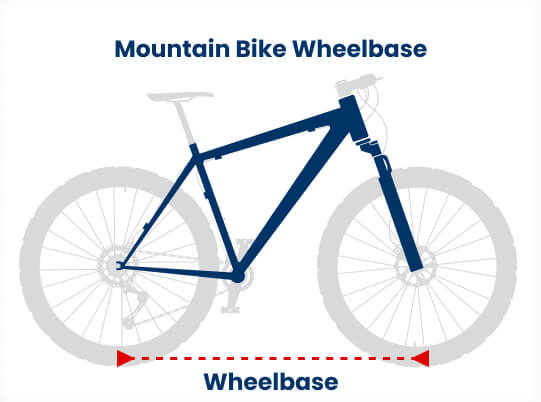
The wheelbase of a mountain bike refers to the measurement between the front and rear axles.
- Wider Wheelbase: A wider wheelbase (meaning a longer distance between the axles) tends to enhance stability — especially at high speeds and on rough terrains.
- Shorter Wheelbase: A shorter wheelbase (with a shorter distance between the axles) offers improved agility and responsiveness.
Have Fun Out There!
Ready to take on those challenging mountain trails? Shop our selection of men's mountain bikes and women's mountain bike — available in a range of brands, price points, and styles. Conquer jumps, rough terrain, and steep inclines. Have the adventure of a lifetime on your mountain bike!


